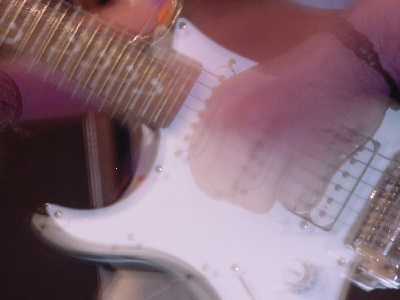How to Attain Maximum Guitar Speed And Dexterity
 Some guitarists want to groove; some just want sit back, relax, and play their instrument in a leisurely manner. Some of us just want to play fast.
Some guitarists want to groove; some just want sit back, relax, and play their instrument in a leisurely manner. Some of us just want to play fast.
If you want to learn how to play fast, you are going to need to be willing to dedicate a lot of time to practice. Luckily, if you are willing to do so, we can walk you through, step by step.
To practice for maximum guitar speed, you will need to play slowly. Sound crazy, right?
Starting Slow Will Help You Win The Race
Starting off patterns slowly is the quickest way to play them faster. If you are a speed demon looking to melt faces, you will need to befriend a metronome. In fact, you will need to make your best friend, your right hand man; your idol. Playing a pattern slowly along with a metronome helps you to build up muscle memory. Muscle memory allows you to play faster with less effort.
Using less effort makes you more efficient, and allows you to further push yourself. The fact that a metronome is a steady tempo keeper means you yourself will become a steady tempo keeper.
Tempo is the most important part of playing fast, as the higher the tempo, the faster you are playing. Playing along with a metronome helps your body to develop its own steady sense of rhythm, which will make playing faster much easier.
Staying Relaxed When Playing
The most overlooked aspect of fast guitar playing is form. To achieve your maximum guitar speed, you need to be relaxed. If you notice that your forearm or bicep is constantly sore after playing, this means you are too tense.
Being tense while playing fast will only slow you down. This is why the above is so important; most guitarists unknowingly tense up when they force themselves to play a pattern that they aren’t yet familiar with at too high of a speed.
Proper muscle memory will allow the rest of your body to relax, as it will be your fingers and wrists doing all of the work. This is what you want. If you find yourself flexing, you should slow down and take your time to relearn the pattern properly.
Focusing On Your Picking Hand
Pay attention to your hand height; your hand should be no more than half an inch off of the strings at any given time. The further your hand has to travel to reach the strings, the slower you will be. Try resting the butt of your palm on the corner of your bridge. It will allow your arm to relax, putting all of the emphasis on the wrist technique.
You may think that building speed is all about your fretting hand, but you are wrong. Chances are, your fretting hand is already fast enough to play at maximum speed.
It’s your picking hand that you should focus on, and this is why it is so important to be aware of form; if your picking hand is several steps behind your fretting hand skill wise, you won’t be able to play fast.
Keep an eye on your form, and pay attention to your body’s signals; if you feel pain, stop playing, take a day off, then come back and play slowly. The pain will be a result of bad form or improper warm up, so be sure to keep an eye on both, and whichever is lacking, work on. Remember, the metronome is your best friend, so use it well.
Scale Runs for Speed Playing
Scales are the number one speed builders.
Why?
They are the foundation of everything you will be playing. Learning the foundation of everything you will be playing and familiarizing yourself with the notes and patterns will allow you to play it quicker.
Start off with your basic major scales and minor scales. Begin by playing a single scale in ascending (lowest note to highest note) order. Alternate pick the scale. Once you are comfortable with the scale, instead of increasing the metronome, play it as legato. This means that, since the scale is in ascending order, all of the notes will be hammer ons. The only time your pick should be involved is when you are moving up a string.
Increase The Tempo Later
After you are fully familiar with both the alternate picked and legato versions of the scale, play it in descending order. Once more, start off with alternate picking, and as you become more comfortable, switch to legato.
When you are fully comfortable with both ways, try playing from ascending to descending, and then descending to ascending. This will allow you to fully familiarize yourself with the scale. After you are finished, you can worry about increasing the tempo.
When you do increase the tempo, be sure to pay attention to your note placements. Your notes should be as evenly placed at 120bpm as they were at 60bpm. If they aren’t, you are going too fast and you need to slow down. Playing slow is the key to playing fast, as it develops the muscle memory required to become fluent with the notes.
If you find the scale runs becoming easy, try skipping between the scales. If you are playing a C Major scale that covers the low E, A, D, and G strings, try playing the scale E string to D string then A string to G string. This will help you to develop the ability to switch positioning on the neck quickly and accurately.
In the end, practice is the best exercise. Devote a section of your practice to these speed building exercises. Soon enough you will begin to see an improvement in both your speed and your accuracy. Have fun!
Guitar Lessons Guaranteed to Help You See Massive Improvements!

Jamplay is the BEST online guitar lesson website that offers step-by-step videos in high definition. They cover EVERY genre of guitar styles and have exhaustive content for musicians of any skill level.
Jamplay also showcases a continuously growing archive of video lessons that are updated weekly. In addition to that, they also offer detailed tutorials for members to learn popular songs with the help of precise, dynamic tabs and song visualizations.
p.s: We have set up a wonderful deal for GuitarPlayerWorld.com’s visitors. Get your exclusive Jamplay promotion code here…






Leave A Comment